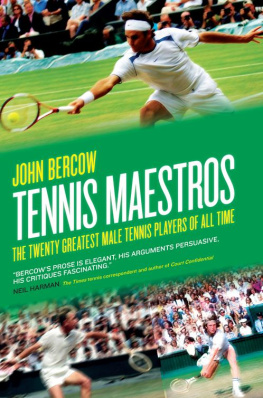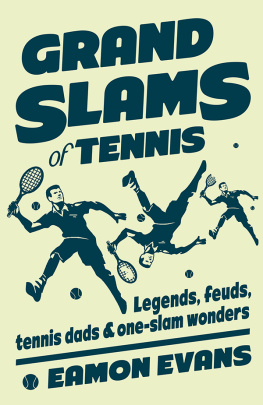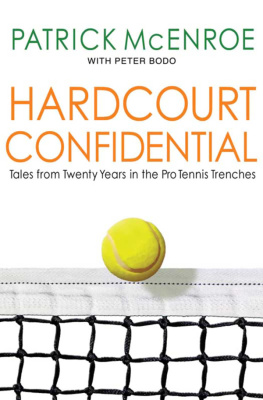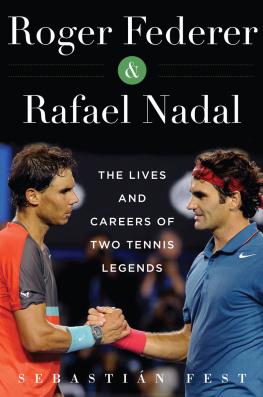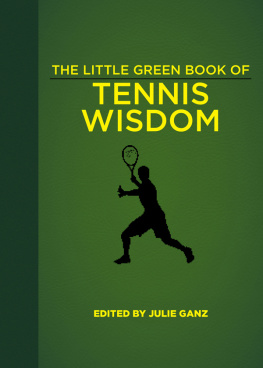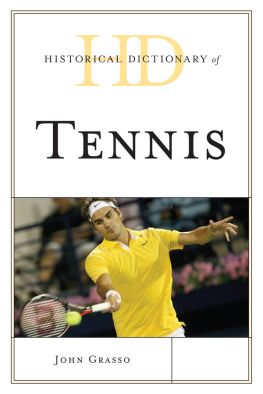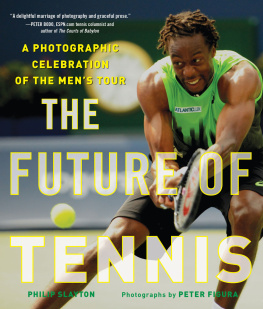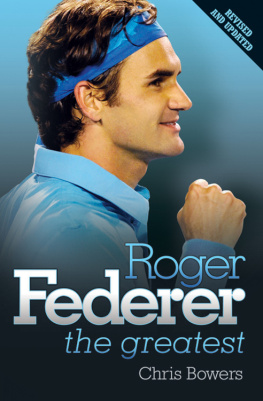Iain Dale of Biteback Publishing readily offered to publish the book and I am grateful to him and his team for all of their support. Vivien Smiley undertook early research on the project with great skill and I am obliged to her as well as to Roger Draper and Bruce Phillips who recommended Vivien for the purpose. John Barrett, now retired from BBC commentary, has over six decades experience of tennis and I have known him for nearly forty years. He has a more comprehensive knowledge of the sport than anyone I know and has been unstintingly generous in sharing his time and insights with me. Alan Little MBE at the Wimbledon Lawn Tennis Museum opened its doors to me and, supported by the excellent Audrey Snell, was happy to let me consult records there. Greg Rusedski, Barry Cowan and Neil Harman have all offered thoughts about particular players which I have appreciated. I am also grateful to the exceptionally talented Michael Cole for providing the excellent photographs in this book. Perhaps my biggest single thanks are due to Sadie Smith. After working as my parliamentary assistant, she could be forgiven for wanting respite outside of office hours. Yet she willingly volunteered to do research, by appointment with Biteback, and to type my manuscript on her computer. She has done so with typical efficiency and without complaint. Of course I am grateful to my wife, Sally, and our three young children, who have stoically put up with me working on the book. All are a tad amused by my passion for the game and preoccupation with its greats, but I appreciate their understanding. Finally, whatever views or advice people have offered, I am alone responsible for the contents of the book.
FOR SPORTS LOVERS everywhere, it is the ultimate question. Whether we are passionate about football or boxing, cricket or baseball, golf or tennis, or indeed any of the other professional pastimes that are played for the entertainment of the masses, the one thing we all want to know is this: who was the greatest performer of them all?
It is a question about which we all have opinions sometimes strong ones. Would you rate Muhammad Ali (alias Cassius Clay) ahead of Joe Louis, the Brown Bomber, as the worlds greatest heavyweight champion? Or perhaps Jack Dempsey, Rocky Marciano, Joe Frazier or even George Foreman would be your choice?
What about the golfers? Where do you place Harry Vardon or Bobby Jones alongside Jack Nicklaus, Arnold Palmer or Tiger Woods?
The arguments are endless and inconclusive, simply because in most sports it is impossible to compare performers of different generations who never competed against one another. The exceptions, of course, are those sports like athletics and swimming where the clock and the tape measure are the ultimate judges of performance, regardless of era. Even then, there are problems. What about the improvements in performance due to technological advances in track and pool manufacture (yes, the swimmers insist that there are fast pools and slow pools), as well as innovations in equipment. Then there are the improved training methods enjoyed by todays athletes, plus greater knowledge about dietary supplements. How have they improved performances?
As he explains in this fascinating volume, John Bercow is aware of the pitfalls. In attempting to place the top twenty gladiators of mens tennis in ascending order, he realises that the game played by todays champions using modern equipment is very different from the one played by those from the era of wooden rackets. Playing surfaces, too, have changed and so have the tennis balls.
Nevertheless, John has bravely attempted to answer that ultimate question and for that we should all be grateful. His list is certain to promote protest and debate, a situation he is familiar with as Speaker of the House of Commons. Nevertheless, his arguments do have a certain logic. As he introduces us to the great players of the past and present (and each biographical sketch is very well researched), there are facts and figures aplenty to support his case, many of which will be unknown to the casual reader.
What emerges from all this is Johns firm grasp of his subject. His love affair with tennis began early. I remember him as one of those promising young players, each of whom had won an official LTA age-group tournament, who were invited to attend the clinics I was organising in the mid-1970s for the BP International Tennis Fellowship. John was one of those determined and dedicated youngsters at our clinic in Ilkley. His speed about the court was commendable as John Lloyd played a tie-break against him and his enthusiasm was boundless. Clearly, he was relishing the challenge.
John brings that same energy and enthusiasm to his writing. As someone who has followed the game closely ever since those days of his youth, he has formed opinions about the players that he shares with us quite openly. Whether we agree with his conclusions is a matter for individual readers to decide.
Order, order. Let the debate begin.
WHY HAVE YOU written a book about tennis? Several friendly acquaintances, who dont know me especially well, have asked that question, entirely reasonably. I have never been a professional player or commentator. In the tennis world there are a great many experts and I am not one of them. My name is almost entirely unknown in tennis circles and insofar as it is known, some might realise that I have two day jobs as a local Member of Parliament and as Speaker of the House of Commons.
The truth is that I started playing and watching tennis at the age of eight in 1971 and I have been a passionate fan of the sport ever since. I played as a junior in north London until my late teens and was nowhere near good enough to contemplate a career as a competitor, but I had a lot of fun and qualified as a coach in the early 1980s. Today, I play for recreation and I adore the game more than ever.
More particularly, I have enjoyed watching the mens and womens singles finals at Wimbledon, overwhelmingly on BBC television and very occasionally in person, every year since 1972, when Stan Smith and Billie Jean King won the titles. I have had the pleasure too of viewing a great many other Slam finals and, in more recent years, I have watched matches on the professional circuit throughout the year thanks to Sky Sports and Eurosport. In short, when I am not working, relaxing with my wife and three children, swimming, watching Arsenal at the Emirates, or reading a book, the chances are that I am playing or watching tennis.
Of the twenty players covered in the book, I have had the privilege of watching eleven of them live, from Jimmy Connors onwards, playing at the peak of their powers. In addition, I have seen recordings of the other nine greats from Bill Tilden to Rod Laver.
So it is from the unashamed vantage point not of an expert but of an enthusiast that I have penned this book. Of course, there is no agreement, even between experts, as to the greatest player of all time and there will not even be a consensus as to who should be in the top twenty. Sure enough, the record book is an invaluable guide to who won what, and when. That said, there have inevitably been many players with similar numbers of titles to their names and the choice of a top twenty, unless decided by the narrowest statistical criteria, is inevitably subjective and, ultimately, personal. I have chosen in this volume to focus only on men simply because, other than in mixed doubles, women do not compete against men and, as a young man, I was first drawn to observation of the mens game.

